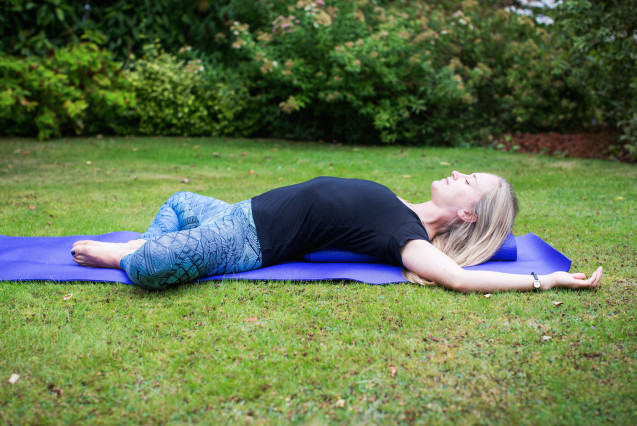Alice Blunden, Articles, Chinese Medicine, In the Press, Mental Health, Yin, Restorative and Meditation, Yoga Medicine® News
3 Incredibly Simple Ways To Manage Anxiety
We are thrilled to share this wonderful article by our very own Senior YM teacher Alice Louise Blunden. Alice recently completed the 500hr Chinese Medicine and Myofascial Release module in Spain and wrote this wonderful piece on how to manage anxiety and TCM which was published by Mind Body Green.
3 Incredibly Simple Ways To Manage Anxiety
By Alice Louise Blunden.
We’ve all experienced anxiety at some point in our lives. Whether it’s speaking in front of large groups people or performing on stage, that familiar rush of adrenaline is totally normal, and actually (believe it or not!) quite helpful. However, when anxiety becomes excessive, it can have debilitating effects. While certain medications can help you deal with these feelings, some fundamental changes also need to be made to your life for longterm freedom from anxiety. According to Traditional Chinese Medicine, emotional stress and anxiety are tied to the kidneys and the heart. We can implement some theories of Chinese Medicine into our yoga practice to support the re-balancing of these organs to help alleviate our anxiety. Here are three simple tips that combine traditional asana with Chinese Medicine to help you de-stress and deal with anxiety:
1. Heart: Supported Reclining Bound Angle Pose (Variation)
Supta Baddha Konasana
A restorative pose like Reclining Bound Angle is an effective way to soften the feelings of anxiety by rebalancing the heart.

Roll up your yoga mat until its diameter is between 3-4 inches. Lie back so that it supports the length of your spine, and your shoulder blades can rest on either side of the mat. You may need to adjust the width of your mat to make sure it is comfortable for you and be sure that it supports your head.
Bend your knees and let them fall out to the side while you bring the soles of your feet together into Baddha Konasana. Place your arms overhead in a cactus shape, so that your elbows are at the same height or higher than your shoulders.
Practice this pose daily in the morning or evening, and stay for 3-5 minutes. Pay close attention to your breath and try to make each exhalation slightly longer than your inhalation. This will help you relax.
2. Kidneys: Reclining Big Toe Pose (Variation)
Supta Pandangushasana
Reclining Big Toe Pose is an effective way to ease anxiety by rebalancing the kidneys.
Take a yoga strap and make a big loop, then hook the strap around the back of your skull. Raise one leg up and hook the other end of the strap around the sole of your foot. Hold onto the strap with your hands on either side (avoid bunching the strap together in the middle).
If you do not have a strap, simply raise your leg and hold onto the back of the thigh or calf (or foot, if this is possible for you). You will be holding this pose for several minutes so refrain from pushing yourself into your deepest variation of this pose. You want it to be relaxing, so if you find that your leg starts shaking, just ease off slightly so that you can find a softness in the pose.
It is natural for your shoulders to rise slightly away from the ground, but your aim here is to let them to fall back toward the mat. As before, practice this pose daily and hold for 3-5 minutes, paying close attention to your breathing through your nose. Notice the cool air as you breathe in and the warm air as you breathe out. If you mind wanders, simply bring it back to the quality of your breath and the sensations around you.
3. Mind: 5-Minute Meditation
If you struggle with anxiety, it’s important to keep your meditation practice simple and with very specific guidelines. This will help ease feelings of stress. For example, try counting the breath for 5 minutes when you wake up in the morning or go to sleep at night.
Alternatively, find a comfortable seat on a cushion so that your hips are slightly above your knees. Sit up tall and rest the palms of your hands on your knees. Let your shoulders be soft and allow your elbows to hang directly below your shoulders. Close your eyes and begin by just noticing the quality of your breath as you breathe in and out through your nose. After a few breaths, start counting: 5 counts for your inhale, 5 counts for your exhale. Continue this for 5 minutes (you can always set an alarm to remind you when to stop). An additional 1-2 minutes can be practiced as needed throughout the day.
Routine is fundamental to easing anxiety. Whether it is waking up each morning and meditating, or going on a run, both your body and your mind will benefit from this clear structure. All too often, we have unrealistic expectations of ourselves, which when we don’t reach, that can induce stress and anxiety. So keep it short and simple and build up your routine over time. Making just one small change that you continue every day, will have a greater impact then practicing everything in excess just once a month.
Start by introducing these three elements into your daily routine gradually, and choose a time that makes sense for you in order to stay consistent. Even if you begin by doing each pose for just one minute a day, that is still progress!
Click Here to read the full article.












